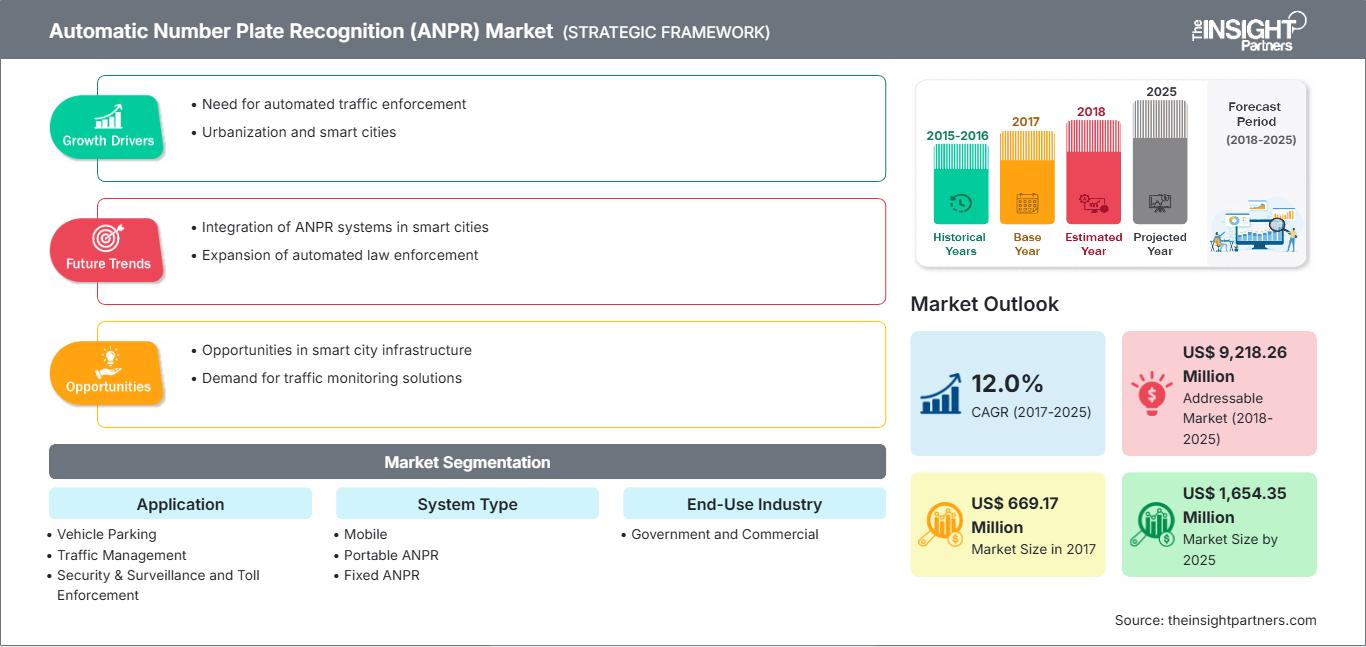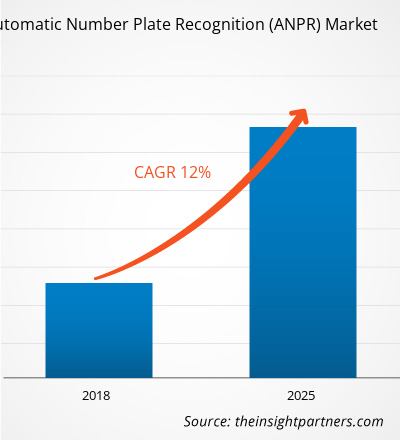Se espera que el mercado global de reconocimiento automático de matrículas crezca de US$ 669,17 millones en 2017 a US$ 1.654,35 millones en 2025 a una CAGR del 12,0% entre 2017 y 2025.
Se prevé un alto crecimiento del mercado de reconocimiento automático de matrículas a nivel mundial en el futuro próximo. Algunos de los principales factores que impulsan este crecimiento son la creciente aceptación del concepto de estacionamiento inteligente tanto en países desarrollados como en desarrollo y el crecimiento de la infraestructura en los países emergentes. Sin embargo, el desarrollo de una plataforma compartida para el intercambio de datos de distintas fuentes y los avances tecnológicos son algunas de las tendencias futuras del mercado de reconocimiento automático de matrículas durante el período de pronóstico.
Perspectivas del mercado
El segmento de aplicaciones de seguridad y vigilancia está ganando terreno a nivel mundial
La aparición del concepto de Reconocimiento Automático de Matrículas se centró principalmente en la monitorización de vehículos. Diversos países del mundo se enfrentan a diversos tipos de delitos, y los delitos relacionados con vehículos estaban en aumento debido a la facilidad de escape a través de ellos. Reducir estos delitos se había hecho necesario, por lo que el uso de sistemas ANPR integrados en los sistemas de seguridad ha demostrado ser de gran utilidad. Asimismo, gobiernos de todo el mundo han establecido diversas normativas sobre límites de velocidad y la propiedad de vehículos para controlar los problemas de congestión vehicular y contaminación atmosférica, especialmente en áreas metropolitanas. Por lo tanto, el control de estas normativas se ve reforzado por el uso de cámaras ANPR, lo que ha impulsado su adopción en el mercado.
Obtendrá personalización en cualquier informe, sin cargo, incluidas partes de este informe o análisis a nivel de país, paquete de datos de Excel, así como también grandes ofertas y descuentos para empresas emergentes y universidades.
Mercado de Reconocimiento Automático de Matrículas (ANPR): Perspectivas Estratégicas

- Obtenga las principales tendencias clave del mercado de este informe.Esta muestra GRATUITA incluirá análisis de datos, desde tendencias del mercado hasta estimaciones y pronósticos.
Se espera que el mercado del reconocimiento automático de matrículas florezca en Asia Pacífico
La región Asia Pacífico, compuesta por varios países en desarrollo como China, Japón, Corea del Sur e India, está experimentando un fuerte crecimiento demográfico, lo que genera una mayor demanda de mejores servicios públicos. El mercado del reconocimiento automático de matrículas en Asia Pacífico ha experimentado un crecimiento significativo gracias al creciente uso de dispositivos conectados y a la industrialización. Australia lidera la implementación de sistemas de reconocimiento automático de matrículas, mientras que China y Corea del Sur representan la segunda mayor cuota de mercado en términos de ingresos en la región APAC, con numerosas iniciativas inteligentes en marcha en los sectores de ANPR e ITS. Se prevé que estos factores impulsen aún más la demanda de reconocimiento automático de matrículas en la región APAC.
El desarrollo de nuevos productos se ha considerado la estrategia más adoptada en el mercado global de reconocimiento automático de matrículas. A continuación, se enumeran algunas de las estrategias recientes de algunos actores del mercado de reconocimiento automático de matrículas:
2017: La empresa 3M presentó una cámara ANPR "revolucionaria".
2017: Siemens completó la implementación de un sistema permanente de control de velocidad promedio en Londres.
2017: Q-Free participa en su tercer proyecto de ITS Cooperativo Australiano (C-ITS), junto con el Departamento de Transporte y Carreteras Principales de Queensland (TMR).
2017: La tecnología de Reconocimiento Automático de Matrículas (ALPR) Intrada de Q-Free está certificada para funcionar con el software de la empresa estadounidense C2P.
Perspectivas regionales del mercado de reconocimiento automático de matrículas (ANPR)
Los analistas de The Insight Partners han explicado detalladamente las tendencias regionales y los factores que influyen en el mercado del Reconocimiento Automático de Matrículas (ANPR) durante el período de pronóstico. Esta sección también analiza los segmentos y la geografía del mercado del Reconocimiento Automático de Matrículas (ANPR) en Norteamérica, Europa, Asia Pacífico, Oriente Medio y África, y Sudamérica y Centroamérica.
Alcance del informe de mercado de reconocimiento automático de matrículas (ANPR)
| Atributo del informe | Detalles |
|---|---|
| Tamaño del mercado en 2017 | US$ 669,17 millones |
| Tamaño del mercado en 2025 | US$ 1.654,35 millones |
| CAGR global (2017-2025) | 12.0% |
| Datos históricos | 2015-2016 |
| Período de pronóstico | 2018-2025 |
| Segmentos cubiertos | Por aplicación
|
| Regiones y países cubiertos | América del norte
|
| Líderes del mercado y perfiles de empresas clave |
|
Densidad de actores del mercado de reconocimiento automático de matrículas (ANPR): comprensión de su impacto en la dinámica empresarial
El mercado del Reconocimiento Automático de Matrículas (ANPR) está en rápido crecimiento, impulsado por la creciente demanda del usuario final debido a factores como la evolución de las preferencias de los consumidores, los avances tecnológicos y un mayor conocimiento de las ventajas del producto. A medida que aumenta la demanda, las empresas amplían su oferta, innovan para satisfacer las necesidades de los consumidores y aprovechan las tendencias emergentes, lo que impulsa aún más el crecimiento del mercado.

- Obtenga una descripción general de los principales actores clave del mercado de Reconocimiento automático de matrículas (ANPR)
Segmentación del mercado del reconocimiento automático de matrículas a nivel mundial
Por aplicación
- Estacionamiento de vehículos
- Gestión del tráfico
- Seguridad y vigilancia
- Control de peajes
Por tipo de sistema
- Móvil
- ANPR portátil
- ANPR fijo
Por el usuario final
- Gobierno
- Comercial
Por geografía
- América del norte
- A NOSOTROS
- Canadá
- México
- Europa
- Francia
- Alemania
- Italia
- Reino Unido
- Asia Pacífico (APAC)
- Japón
- Porcelana
- India
- Resto de APAC
- Oriente Medio y África (MEA)
- Sudáfrica
- Emiratos Árabes Unidos
- América del Sur (SAM)
- Brasil
Perfiles de empresas
- Compañía 3m
- ARH, Inc.
- Tecnologías COBAN, Inc.
- Sistemas de reconocimiento digital, Ltd.
- Genetec, Inc.
- Jenoptik AG
- ASA sin Q
- Siemens AG
- Tattile SRL
- Soluciones Vigilant
- Análisis histórico (2 años), año base, pronóstico (7 años) con CAGR
- Análisis PEST y FODA
- Tamaño del mercado, valor/volumen: global, regional y nacional
- Industria y panorama competitivo
- Conjunto de datos de Excel
Informes recientes
Testimonios
Razón para comprar
- Toma de decisiones informada
- Comprensión de la dinámica del mercado
- Análisis competitivo
- Información sobre clientes
- Pronósticos del mercado
- Mitigación de riesgos
- Planificación estratégica
- Justificación de la inversión
- Identificación de mercados emergentes
- Mejora de las estrategias de marketing
- Impulso de la eficiencia operativa
- Alineación con las tendencias regulatorias






















 Obtenga una muestra gratuita para - Mercado de Reconocimiento Automático de Matrículas (ANPR)
Obtenga una muestra gratuita para - Mercado de Reconocimiento Automático de Matrículas (ANPR)